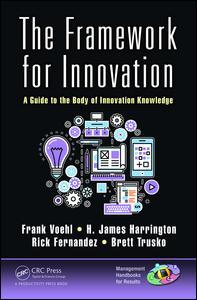The Framework for Innovation A Guide to the Body of Innovation Knowledge Management Handbooks for Results Series
Auteurs : Voehl Frank, Harrington H. James, Fernandez Rick, Trusko Brett

The innovation infrastructure and master plan described in this book offers a detailed and comprehensive approach to one of the most difficult and challenging problems facing entrepreneurs involved in innovation at any scale enterprise: the problem of how to govern your organization?s innovation initiatives in the middle of turbulent change. Progress in any field requires the development of a framework, a structure that organizes the accumulating knowledge, enables people to master it, and unifies the key discoveries into a set of principles that
makes them understandable and actionable.
For starters, successful innovation requires an integrated design process, beginning with integration in the design of the enterprise, the design of the product, along with the design and implementation of new technologies. Such an integrated design effort requires good collaboration and management of the design framework, and should be supported by efficient knowledge management techniques and tools; If innovation is to help a business grow and improve its competitiveness, it is also important to plan the innovation carefully.
This book provides a holistic, multidisciplinary framework that will enable your organization and its leaders to take a strategic approach to innovation. The framework combines non-traditional,
creative approaches to business innovation with conventional strategy development models. The framework model brings together perspectives from many complementary disciplines: the non-traditional approaches to innovation found in the business creativity movement; multiple-source strategy consulting; the new product development perspective of many leading industrial design firms; qualitative consumer/customer research; future-based research found in think tanks and traditional scenario planning; and organizational development (OD) practices that examine the effectiveness of an organization?s culture, processes, and structure.
Though some ideas may just "fall from the sky" or "come out of the blue", an organization should also have a strategic vision of how the business and the enterprise will successfully develop. It should not just wait for the innovation to arrive arbitrarily, but rather proactively plan for innovation incorporating market trends, the competitive landscape, new technology availability, and changes in customer preferences and trends in order to create a flexible in-house innovation process. Such an enterprise will also pro-actively manage the knowledge supply chain that supports innovation, as outlined in this book #7 of Management Handbook for Results series.
The framework outlined in this handbook consists of a well-integrated cohesive set of practices that inspires imaginative innovation teams to look beyond the obvious and explore a broad range of possibilities to identify significant opportunities and make informed decisions about the most promising paths to pursue. The goal is to create a shared vision for growth, along with defining pragmatic action plans that bridge from the future back to the present, while attempting to align the organization around the requirements for success.
1. Preparing your Organization for Innovation 2. Promoting and Communicating 3. Personal Creativity for Entrepreneurs 4. Corporate Creativity and Innovation 5. Innovation Theory for Entrepreneurs 6. Business Essentials for Innovative Entrepreneurs 7. Innovation Readiness and Deployment 8. The Innovation Process 9. Innovation and Consumer/Customer Insight 10. Building a Strong Organizational Foundation for Innovation 11. Innovation Methods 12. Managing an Intellectual Property Portfolio 13. TRIZ & STEM Joined at the Hip 14. Global Innovation Problem Areas and Quality of R&D Ideas 15. Total Innovation Management for Excellence (Time)
Frank Voehl is an expert in the application of the business improvement tools and innovation methods to public and private organizations, including city, country, community government, and non-profit operations, a Grand Master Black Belt Instructor in Lean Six Sigma and Performance Management, and noted author and series editor of over 30 books and hundreds of business management and improvement articles and technical papers. In addition, he has provided input on the original design of the Malcolm Baldrige National Quality Award, and facilitated its crossover to other nations and regions, including the Bahamas, South America, Europe and the Czech Republic.
Specialties: (1) Certified (Six Sigma) Application Expert, JUSE (2) Lifetime Master Instructor, QualTec Institute (3) Lean Six Sigma Grand Master Black Belt, Harrington Institute; PPN; IQF (4) ISO 9000 Lead Auditor, ASQ; Quest; Eagle (5) TQM Quality Counselor/Advisor, Crosby Quality College (6) Certified Management Consultant, CMC.
Dr. H James Harrington now serves as the International Quality Advisor for Ernst & Young and Chairman of the Board of Emergence Technology, Ltd., a high tech software manufacturer and developer. He also serves on the Board of Directors of a number of national and international companies. Dr. Harrington is past Chairman and past President of the prestigious International Academy for Quality and of the American Society for Quality control. He is an "A" level member of ISO’s T.C. 176 that wrote the ISO 9000 Quality System standards and T.C. 207 that wrote the ISO 14000 environmental standards. He is a member of the Board of Directors of the 14000 Environmental Management Foundation. Since joining Ernst & Young, Dr. Harrington has divided his time between working with executives to develop and implement performance improvement plans, and developing new approaches to performance improvement. As a member of the Nat
Date de parution : 09-2018
15.6x23.4 cm
Disponible chez l'éditeur (délai d'approvisionnement : 15 jours).
Prix indicatif 50,12 €
Ajouter au panierThèmes de The Framework for Innovation :
Mots-clés :
Pop Star; Brett Trusko; PhD Level Education; H; James Harrington; Organization’s DNA; Rick Fernandez; Total Innovation System; Chief Innovation Officer; Common Language; Town Hall; Business Process; Stem Education; Innovation Benchmarking; Stem Knowledge; Integrate Stem Education; Stem Community; Integrate Stem; Ceo’s Time; Standards Setting Process; Stem Professional; International Telecommunications Union; Stem Curriculum; Ipr Policy; Idea Management System; Transformational Innovation; Innovation Process Model; Patent Holder; Suggestion Boxes



